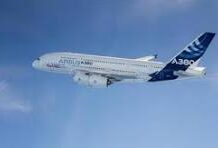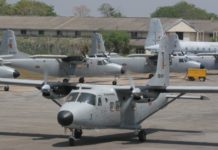Compiled by: Gp Capt Kumar Kirinde [retd], SLAF
Introduction
The Messerschmitt Me 262 aircraft, nicknamed Schwalbe (German for ‘Swallow’) in fighter versions, or Sturmvogel (‘Storm Bird’) in fighter-bomber versions, was the world’s first operational jet-powered fighter aircraft. Design work started before World War II, but problems with engines, metallurgy and top-level interference kept the aircraft from entering service with the Luftwaffe until mid-1944.

The Me 262 was faster and more heavily armed than any Allied fighter, including the British jet-powered Gloster Meteor, and one of the most advanced aviation designs in operational use during World War II. Its roles included light bomber, reconnaissance, and experimental night fighter sorties.
Me 262 pilots claimed a total of 542 Allied aircraft shot down, although higher claims are sometimes made. The Allies countered its effectiveness in the air by attacking the aircraft on the ground and during takeoff and landing. Attacks by Allied forces on fuel supplies during the deteriorating late-war situation also reduced the effectiveness of the aircraft as a fighting force. In the end, the Me 262 had a negligible impact on the course of the war because of its late introduction and the consequently small numbers deployed in operational service.
Design and development
Several years before World War II, the Germans foresaw the great potential for aircraft using jet propulsion. This thinking was reinforced with the successful test flights of the world’s first jet aircraft—the Heinkel He 178—within a week of the German invasion of Poland, which triggered World War II. However, the Me 262 development project was underway before the war commenced. It was consequent to a request made by the Reich Air Ministry for a jet aircraft capable of one hour’s endurance and a speed of at least 850 kph (530 mph; 460 knots).
Plans were first drawn up in April 1939, and the original design was significantly different from the aircraft that eventually entered service.
Progression of the original design was delayed greatly by technical issues involving the new jet engine. Funding for the jet engine program was also initially lacking as many high-ranking officials thought the war could easily be won with conventional aircraft. Among those were Hermann Göring, head of the Luftwaffe, who cut staffing on the engine development program to only 35 engineers in February 1940. By that time, problems with engine development had slowed production of the Me 262 considerably. The aircraft made its first successful flight entirely on jet power on 18 July 1942.
 3-view drawing of the Messerschmitt Me 262
3-view drawing of the Messerschmitt Me 262
Testing


Testing showed that the Me 262 handled much better than piston-engine fighters such as the Messerschmitt Bf 109 or Focke-Wulf Fw 190. Handling was so improved over the previous aircraft that a report by Major Ernst Englander stated that any Bf 109 pilot could convert to the Me 262 with only an hour of instruction. According to his report, even bomber pilots who converted to fly the Me 262 only required three instruction flights, and less than 5% had any difficulty retraining. The Me 262 had gentler stall and landing characteristics compared to earlier German fighters. Its handling improved with speed, and much less speed would be lost during turns, a vital consideration in the fighter-combat role. It had a cruising speed of 465 mph, which was faster than the top speed of most other fighters of the day, and visibility in every direction was much better compared to preceding German fighters.
Hitler’s influence on deciding the role of the aircraft
In mid-1943 Adolf Hitler envisioned the Me 262 as a ground-attack/bomber aircraft rather than a defensive interceptor. The configuration of a high-speed, light-payload Schnellbomber (‘fast bomber’) was intended to penetrate enemy airspace during the expected Allied invasion of France. Albert Speer, then Minister of Armaments and War Production, claimed in his memoirs that Hitler had originally blocked mass production of the Me 262, before agreeing to proceed in early 1944. Hitler rejected arguments that the aircraft would be more effective as a fighter against the Allied bombers which were destroying large parts of Germany and wanted it as a bomber for revenge attacks. According to Speer, Hitler felt the Me 262’s superior speed compared to other fighters of the era meant it could not be attacked, and so preferred it for high-altitude straight flying.


Production
About 1,400 examples of the Me 262 were produced, but a maximum of 200 were operational at any one time. According to sources they destroyed from 300 to 450 enemy airplanes, with the Allies destroying approximately 100 Me 262s in the air. While Germany was bombed intensively, Me 262 production was dispersed into low-profile production facilities, sometimes little more than clearings in the forests of Germany and occupied countries. From the end of February to the end of March 1945, approximately sixty Me 262s were destroyed in attacks.
Large, heavily protected underground factories were constructed to take up production of the Me 262 while remaining safe from bomb attacks. A disused mine complex under a mountain was adapted for the production of complete aircraft. These were hauled to the flat top of the hill, where a runway had been cleared, and flown out. Between 20 and 30 Me 262s were built here, the underground factory being overrun by Allied troops before it could reach a meaningful output. Wings were produced in Germany’s oldest motorway tunnel. In a vast network of tunnels in Austria, slave labourers from a concentration camp produced fully-equipped fuselages for the Me 262 at a monthly rate of 450 units on large assembly lines commencing in early 1945. An estimated 35,000 to 50,000 people died on the forced labour details for the Me 262.
Operational history
On 19 April 1944, Erprobungskommando 262 was formed as a test unit [named Jäger Erprobungskommando Thierfelder, commanded by Hauptmann (Capt) Werner Thierfelder]. Its task was to introduce the Me 262 into service and train a corps of pilots to fly it.
Major Walter Nowotny was assigned as commander after the death of Thierfelder in July 1944, and the unit redesignated Kommando Nowotny. Essentially a trials and development unit, it launched the world’s first jet fighter operations. Trials continued slowly, with initial operational missions against the Allies in August 1944, and the unit made claims for 19 Allied aircraft versus six Me 262s lost.
Despite orders to stay grounded, Nowotny chose to fly a mission against an enemy bomber formation flying at an altitude of 9,100 m (30,000 ft) on 8 November 1944. He claimed two P-51D Mustangs destroyed before his Me 262 suffered engine failure at high altitude. Then, while diving and trying to restart his engines, he was attacked by other Mustangs, forced to bail out, and died. The Kommando was then withdrawn for further flight training and a revision of combat tactics to optimise the Me 262’s strengths.
The Me 262 was so fast that German pilots needed new tactics to attack Allied bombers. In the head-on attack, the combined closing speed of about 320 mps (720 mph) was too high for accurate shooting, with ordnance that could only fire about 44 shells a second (650 rounds per min) from each of the four cannons.
Eventually, German pilots developed new combat tactics to counter Allied bombers’ defences. Me 262s, equipped with up to 24 unguided folding-fin R4M rockets—12 in each of two underwing racks, outboard of the engine nacelle—approached from the side of a bomber formation, where the bombers’ silhouettes were widest, and while still out of range of the enemy airplanes’ machine guns, the Me 262s fired a salvo of rockets One or two of these rockets could down even the famously rugged Boeing B-17 Flying Fortress.
The Me 262 was difficult to counter because its high speed and rate of climb made it hard to intercept. However, the two Junkers Jumo 004B-1 axial-flow turbojet engines did not provide sufficient thrust at low airspeeds and throttle response was slow, so that in certain circumstances such as takeoff and landing the aircraft became a vulnerable target.
Luftwaffe pilots eventually learned how to handle the Me 262’s higher speed and the type soon proved a formidable air superiority fighter. Pilots also soon learned that the Me 262 was quite maneuverable despite its high wing-loading and lack of low-speed thrust, especially if attention was drawn to its effective maneuvering speeds.
Allied pilots soon found that the only reliable way to destroy the jets was to attack them on the ground or during takeoff or landing. Luftwaffe airfields identified as jet bases were frequently bombed by medium bombers, and Allied fighters patrolled over the fields to attack jets trying to land.
During March 1945, Me 262 fighter units were able, for the first time, to mount large-scale attacks on Allied bomber formations. On 18 March, 37 Me 262s of a jet fighter wing intercepted a force of 1,221 bombers and 632 escorting fighters. They shot down 12 bombers and one fighter for the loss of three Me 262s. Although a 4:1 ratio was exactly what the Luftwaffe would have needed to make an impact on the war, the absolute scale of their success was minor, as it represented only 1% of the attacking force.

January 1945 Me-262 being shot down. Note jettisoned canopy and empty cockpit. As seen from USAAF P-51 Mustang gun camera
In the last days of the war, Me 262s were committed on ground assault missions, in an attempt to support German troops fighting Red Army forces. During operations between 28 April and 1 May Soviet fighters and ground fire downed at least ten more Me 262s from the fighter jet wing JG (Jagdgeschwader) 7. However, JG 7 managed to keep its jets operational until the end of the war.
Conclusion
While German use of the Me 262 ended with the close of World War II, a small number were operated by the Czechoslovak Air Force until 1951. It also heavily influenced several designs, such as the Soviets’ Sukhoi Su-9 (1946) and the Japanese Nakajima Kikka (‘Orange Blossom’). Captured Me 262s were studied and flight-tested by the major powers, and ultimately influenced the designs of other post-war jet aircraft such as the North American F-86 Sabre, MiG-15 and Boeing B-47 Stratojet six-engined bomber. Several Me 262s survive on static display in museums, and there are several privately built flying reproductions that use modern General Electric J85 engines.
Sources: https://en.wikipedia.org/wiki/Messerschmitt_Me_262 and Google Images












